Top Ten Animals Native to Africa and Asia
The Top Ten
1 Lion
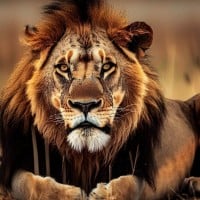 The lion (Panthera leo) is a large cat of the genus Panthera native to Africa and India. It has a muscular, broad-chested body, short, rounded head, round ears, and a hairy tuft at the end of its tail. It is sexually dimorphic; adult male lions are larger than females and have a prominent mane. It is a social species, forming groups called prides. A lion's pride consists of a few adult males, related females, and cubs. Groups of female lions usually hunt together, preying mostly on large ungulates. The lion is an apex and keystone predator; although some lions scavenge when opportunities occur and have been known to hunt humans, the species typically does not actively seek out and prey on humans. ...read more.
The lion (Panthera leo) is a large cat of the genus Panthera native to Africa and India. It has a muscular, broad-chested body, short, rounded head, round ears, and a hairy tuft at the end of its tail. It is sexually dimorphic; adult male lions are larger than females and have a prominent mane. It is a social species, forming groups called prides. A lion's pride consists of a few adult males, related females, and cubs. Groups of female lions usually hunt together, preying mostly on large ungulates. The lion is an apex and keystone predator; although some lions scavenge when opportunities occur and have been known to hunt humans, the species typically does not actively seek out and prey on humans. ...read more.
 The lion (Panthera leo) is a large cat of the genus Panthera native to Africa and India. It has a muscular, broad-chested body, short, rounded head, round ears, and a hairy tuft at the end of its tail. It is sexually dimorphic; adult male lions are larger than females and have a prominent mane. It is a social species, forming groups called prides. A lion's pride consists of a few adult males, related females, and cubs. Groups of female lions usually hunt together, preying mostly on large ungulates. The lion is an apex and keystone predator; although some lions scavenge when opportunities occur and have been known to hunt humans, the species typically does not actively seek out and prey on humans. ...read more.
The lion (Panthera leo) is a large cat of the genus Panthera native to Africa and India. It has a muscular, broad-chested body, short, rounded head, round ears, and a hairy tuft at the end of its tail. It is sexually dimorphic; adult male lions are larger than females and have a prominent mane. It is a social species, forming groups called prides. A lion's pride consists of a few adult males, related females, and cubs. Groups of female lions usually hunt together, preying mostly on large ungulates. The lion is an apex and keystone predator; although some lions scavenge when opportunities occur and have been known to hunt humans, the species typically does not actively seek out and prey on humans. ...read more.
2 Cheetah
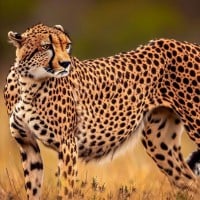 The cheetah (Acinonyx jubatus) is a large cat and native to Africa and central Iran. It is the fastest land animal, estimated to be capable of running at 80 to 128 km/h (50 to 80 mph) with the fastest reliably recorded speeds being 93 and 98 km/h (58 and 61 mph), and as such has several adaptations for speed, including a light build, long thin legs and a long tail. It typically reaches 67–94 cm (26–37 in) at the shoulder, and the head-and-body length is between 1.1 and 1.5 m (3 ft 7 in and 4 ft 11 in). Adults weigh between 21 and 72 kg (46 and 159 lb). Its head is small and rounded, and has a short snout and black tear-like facial streaks. The coat is typically tawny to creamy white or pale ...read more.
The cheetah (Acinonyx jubatus) is a large cat and native to Africa and central Iran. It is the fastest land animal, estimated to be capable of running at 80 to 128 km/h (50 to 80 mph) with the fastest reliably recorded speeds being 93 and 98 km/h (58 and 61 mph), and as such has several adaptations for speed, including a light build, long thin legs and a long tail. It typically reaches 67–94 cm (26–37 in) at the shoulder, and the head-and-body length is between 1.1 and 1.5 m (3 ft 7 in and 4 ft 11 in). Adults weigh between 21 and 72 kg (46 and 159 lb). Its head is small and rounded, and has a short snout and black tear-like facial streaks. The coat is typically tawny to creamy white or pale ...read more.
 The cheetah (Acinonyx jubatus) is a large cat and native to Africa and central Iran. It is the fastest land animal, estimated to be capable of running at 80 to 128 km/h (50 to 80 mph) with the fastest reliably recorded speeds being 93 and 98 km/h (58 and 61 mph), and as such has several adaptations for speed, including a light build, long thin legs and a long tail. It typically reaches 67–94 cm (26–37 in) at the shoulder, and the head-and-body length is between 1.1 and 1.5 m (3 ft 7 in and 4 ft 11 in). Adults weigh between 21 and 72 kg (46 and 159 lb). Its head is small and rounded, and has a short snout and black tear-like facial streaks. The coat is typically tawny to creamy white or pale ...read more.
The cheetah (Acinonyx jubatus) is a large cat and native to Africa and central Iran. It is the fastest land animal, estimated to be capable of running at 80 to 128 km/h (50 to 80 mph) with the fastest reliably recorded speeds being 93 and 98 km/h (58 and 61 mph), and as such has several adaptations for speed, including a light build, long thin legs and a long tail. It typically reaches 67–94 cm (26–37 in) at the shoulder, and the head-and-body length is between 1.1 and 1.5 m (3 ft 7 in and 4 ft 11 in). Adults weigh between 21 and 72 kg (46 and 159 lb). Its head is small and rounded, and has a short snout and black tear-like facial streaks. The coat is typically tawny to creamy white or pale ...read more. They are amazing
3 Rhino
 A rhinoceros, commonly abbreviated to rhino, is a member of any of the five extant species (or numerous extinct species) of odd-toed ungulates in the family Rhinocerotidae. (It can also refer to a member of any of the extinct species of the superfamily Rhinocerotoidea.) Two of the extant species are native to Africa, and three to South and Southeast Asia.
A rhinoceros, commonly abbreviated to rhino, is a member of any of the five extant species (or numerous extinct species) of odd-toed ungulates in the family Rhinocerotidae. (It can also refer to a member of any of the extinct species of the superfamily Rhinocerotoidea.) Two of the extant species are native to Africa, and three to South and Southeast Asia.
Rhinoceroses are some of the largest remaining megafauna: all weigh at least one tonne in adulthood. They have a herbivorous diet, small brains (400–600 g) for mammals of their size, one or two horns, and a thick (1.5–5 cm), protective skin formed from layers of collagen positioned in a lattice structure. They generally eat leafy material, although their ability to ferment food in their hindgut allows them to subsist on more fibrous plant matter when necessary. Unlike other perissodactyls, the two African species of rhinoceros lack teeth at the front of their mouths; they rely instead on their lips to pluck food. ...read more.
 A rhinoceros, commonly abbreviated to rhino, is a member of any of the five extant species (or numerous extinct species) of odd-toed ungulates in the family Rhinocerotidae. (It can also refer to a member of any of the extinct species of the superfamily Rhinocerotoidea.) Two of the extant species are native to Africa, and three to South and Southeast Asia.
A rhinoceros, commonly abbreviated to rhino, is a member of any of the five extant species (or numerous extinct species) of odd-toed ungulates in the family Rhinocerotidae. (It can also refer to a member of any of the extinct species of the superfamily Rhinocerotoidea.) Two of the extant species are native to Africa, and three to South and Southeast Asia.Rhinoceroses are some of the largest remaining megafauna: all weigh at least one tonne in adulthood. They have a herbivorous diet, small brains (400–600 g) for mammals of their size, one or two horns, and a thick (1.5–5 cm), protective skin formed from layers of collagen positioned in a lattice structure. They generally eat leafy material, although their ability to ferment food in their hindgut allows them to subsist on more fibrous plant matter when necessary. Unlike other perissodactyls, the two African species of rhinoceros lack teeth at the front of their mouths; they rely instead on their lips to pluck food. ...read more.
4 Hare
5 Zebra
 Zebras (subgenus Hippotigris) are African equines with distinctive black-and-white striped coats. There are three living species: the Grévy's zebra (Equus grevyi), plains zebra (E. quagga), and the mountain zebra (E. zebra). Zebras share the genus Equus with horses and asses, the three groups being the only living members of the family Equidae. Zebra stripes come in different patterns, unique to each individual. Several theories have been proposed for the function of these stripes, with most evidence supporting them as a deterrent for biting flies. Zebras inhabit eastern and southern Africa and can be found in a variety of habitats such as savannahs, grasslands, woodlands, shrublands, and mountainous areas. ...read more.
Zebras (subgenus Hippotigris) are African equines with distinctive black-and-white striped coats. There are three living species: the Grévy's zebra (Equus grevyi), plains zebra (E. quagga), and the mountain zebra (E. zebra). Zebras share the genus Equus with horses and asses, the three groups being the only living members of the family Equidae. Zebra stripes come in different patterns, unique to each individual. Several theories have been proposed for the function of these stripes, with most evidence supporting them as a deterrent for biting flies. Zebras inhabit eastern and southern Africa and can be found in a variety of habitats such as savannahs, grasslands, woodlands, shrublands, and mountainous areas. ...read more.
 Zebras (subgenus Hippotigris) are African equines with distinctive black-and-white striped coats. There are three living species: the Grévy's zebra (Equus grevyi), plains zebra (E. quagga), and the mountain zebra (E. zebra). Zebras share the genus Equus with horses and asses, the three groups being the only living members of the family Equidae. Zebra stripes come in different patterns, unique to each individual. Several theories have been proposed for the function of these stripes, with most evidence supporting them as a deterrent for biting flies. Zebras inhabit eastern and southern Africa and can be found in a variety of habitats such as savannahs, grasslands, woodlands, shrublands, and mountainous areas. ...read more.
Zebras (subgenus Hippotigris) are African equines with distinctive black-and-white striped coats. There are three living species: the Grévy's zebra (Equus grevyi), plains zebra (E. quagga), and the mountain zebra (E. zebra). Zebras share the genus Equus with horses and asses, the three groups being the only living members of the family Equidae. Zebra stripes come in different patterns, unique to each individual. Several theories have been proposed for the function of these stripes, with most evidence supporting them as a deterrent for biting flies. Zebras inhabit eastern and southern Africa and can be found in a variety of habitats such as savannahs, grasslands, woodlands, shrublands, and mountainous areas. ...read more.
6 Elephant
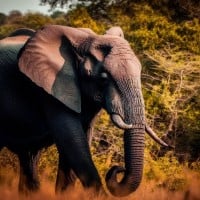 Elephants are the largest existing land animals. Three living species are currently recognised: the African bush elephant, the African forest elephant, and the Asian elephant. They are the only surviving members of the family Elephantidae and the order Proboscidea, extinct relatives include mammoths and mastodons. Distinctive features of elephants include a long proboscis called a trunk, tusks, large ear flaps, pillar-like legs, and tough but sensitive skin. The trunk is used for breathing, bringing food and water to the mouth, and grasping objects. Tusks, which are derived from the incisor teeth, serve both as weapons and as tools for moving objects and digging. The large ear flaps assist in ...read more.
Elephants are the largest existing land animals. Three living species are currently recognised: the African bush elephant, the African forest elephant, and the Asian elephant. They are the only surviving members of the family Elephantidae and the order Proboscidea, extinct relatives include mammoths and mastodons. Distinctive features of elephants include a long proboscis called a trunk, tusks, large ear flaps, pillar-like legs, and tough but sensitive skin. The trunk is used for breathing, bringing food and water to the mouth, and grasping objects. Tusks, which are derived from the incisor teeth, serve both as weapons and as tools for moving objects and digging. The large ear flaps assist in ...read more.
 Elephants are the largest existing land animals. Three living species are currently recognised: the African bush elephant, the African forest elephant, and the Asian elephant. They are the only surviving members of the family Elephantidae and the order Proboscidea, extinct relatives include mammoths and mastodons. Distinctive features of elephants include a long proboscis called a trunk, tusks, large ear flaps, pillar-like legs, and tough but sensitive skin. The trunk is used for breathing, bringing food and water to the mouth, and grasping objects. Tusks, which are derived from the incisor teeth, serve both as weapons and as tools for moving objects and digging. The large ear flaps assist in ...read more.
Elephants are the largest existing land animals. Three living species are currently recognised: the African bush elephant, the African forest elephant, and the Asian elephant. They are the only surviving members of the family Elephantidae and the order Proboscidea, extinct relatives include mammoths and mastodons. Distinctive features of elephants include a long proboscis called a trunk, tusks, large ear flaps, pillar-like legs, and tough but sensitive skin. The trunk is used for breathing, bringing food and water to the mouth, and grasping objects. Tusks, which are derived from the incisor teeth, serve both as weapons and as tools for moving objects and digging. The large ear flaps assist in ...read more.
7 Antelope
8 Crocodile
 Crocodiles (family Crocodylidae) or true crocodiles are large semiaquatic reptiles that live throughout the tropics in Africa, Asia, the Americas and Australia. The term crocodile is sometimes used even more loosely to include all extant members of the order Crocodilia, which includes the alligators and caimans (family Alligatoridae), the gharial and false gharial (family Gavialidae) among other extinct taxa. ...read more.
Crocodiles (family Crocodylidae) or true crocodiles are large semiaquatic reptiles that live throughout the tropics in Africa, Asia, the Americas and Australia. The term crocodile is sometimes used even more loosely to include all extant members of the order Crocodilia, which includes the alligators and caimans (family Alligatoridae), the gharial and false gharial (family Gavialidae) among other extinct taxa. ...read more.
 Crocodiles (family Crocodylidae) or true crocodiles are large semiaquatic reptiles that live throughout the tropics in Africa, Asia, the Americas and Australia. The term crocodile is sometimes used even more loosely to include all extant members of the order Crocodilia, which includes the alligators and caimans (family Alligatoridae), the gharial and false gharial (family Gavialidae) among other extinct taxa. ...read more.
Crocodiles (family Crocodylidae) or true crocodiles are large semiaquatic reptiles that live throughout the tropics in Africa, Asia, the Americas and Australia. The term crocodile is sometimes used even more loosely to include all extant members of the order Crocodilia, which includes the alligators and caimans (family Alligatoridae), the gharial and false gharial (family Gavialidae) among other extinct taxa. ...read more.
9 Chimpanzee
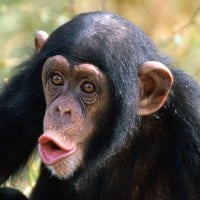 Chimpanzees are primates of the genus Pan which consists of the common chimpanzee and the bonobo. They are a part of the tribe Hominini, which also includes humans, and the family Hominidae where all great apes are included. Like their closest living relatives the modern humans, chimpanzees are social and intelligent animals that have the ability to solve problems, use tools, and communicate with others of their kind without speaking.
Chimpanzees are primates of the genus Pan which consists of the common chimpanzee and the bonobo. They are a part of the tribe Hominini, which also includes humans, and the family Hominidae where all great apes are included. Like their closest living relatives the modern humans, chimpanzees are social and intelligent animals that have the ability to solve problems, use tools, and communicate with others of their kind without speaking.
 Chimpanzees are primates of the genus Pan which consists of the common chimpanzee and the bonobo. They are a part of the tribe Hominini, which also includes humans, and the family Hominidae where all great apes are included. Like their closest living relatives the modern humans, chimpanzees are social and intelligent animals that have the ability to solve problems, use tools, and communicate with others of their kind without speaking.
Chimpanzees are primates of the genus Pan which consists of the common chimpanzee and the bonobo. They are a part of the tribe Hominini, which also includes humans, and the family Hominidae where all great apes are included. Like their closest living relatives the modern humans, chimpanzees are social and intelligent animals that have the ability to solve problems, use tools, and communicate with others of their kind without speaking.
10 Leopard
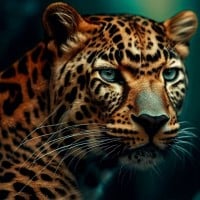 The leopard is one of the five "big cats" in the genus Panthera. It is one of the most adaptable and the most widespread big cat; it's secrets being:well camouflaged fur; its opportunistic hunting behaviour, broad diet, and strength to move heavy carcasses into trees; its ability to adapt to various habitats ranging from rain-forest to steppe and including arid and mountainous areas; and to run at speeds up to 58 kilometres per hour (36 mph).
The common name "leopard" (pronounced /ˈle-pərd/) is a Greek compound of λέων (leōn) ("lion") and πάρδος (pardos) ("male panther"). It lives throughout Asia (except for North Asia) and Africa, including Indonesia.
The leopard is one of the five "big cats" in the genus Panthera. It is one of the most adaptable and the most widespread big cat; it's secrets being:well camouflaged fur; its opportunistic hunting behaviour, broad diet, and strength to move heavy carcasses into trees; its ability to adapt to various habitats ranging from rain-forest to steppe and including arid and mountainous areas; and to run at speeds up to 58 kilometres per hour (36 mph).
The common name "leopard" (pronounced /ˈle-pərd/) is a Greek compound of λέων (leōn) ("lion") and πάρδος (pardos) ("male panther"). It lives throughout Asia (except for North Asia) and Africa, including Indonesia.
 The leopard is one of the five "big cats" in the genus Panthera. It is one of the most adaptable and the most widespread big cat; it's secrets being:well camouflaged fur; its opportunistic hunting behaviour, broad diet, and strength to move heavy carcasses into trees; its ability to adapt to various habitats ranging from rain-forest to steppe and including arid and mountainous areas; and to run at speeds up to 58 kilometres per hour (36 mph).
The common name "leopard" (pronounced /ˈle-pərd/) is a Greek compound of λέων (leōn) ("lion") and πάρδος (pardos) ("male panther"). It lives throughout Asia (except for North Asia) and Africa, including Indonesia.
The leopard is one of the five "big cats" in the genus Panthera. It is one of the most adaptable and the most widespread big cat; it's secrets being:well camouflaged fur; its opportunistic hunting behaviour, broad diet, and strength to move heavy carcasses into trees; its ability to adapt to various habitats ranging from rain-forest to steppe and including arid and mountainous areas; and to run at speeds up to 58 kilometres per hour (36 mph).
The common name "leopard" (pronounced /ˈle-pərd/) is a Greek compound of λέων (leōn) ("lion") and πάρδος (pardos) ("male panther"). It lives throughout Asia (except for North Asia) and Africa, including Indonesia.The Contenders
11 Tiger
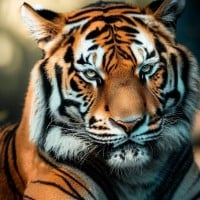 The tiger (Panthera tigris) is the largest living cat species and a member of the genus Panthera. It is most recognisable for its dark vertical stripes on orange fur with a white underside. An apex predator, it primarily preys on ungulates such as deer and wild boar. It is territorial and generally a solitary but social predator, requiring large contiguous areas of habitat, which support its requirements for prey and rearing of its offspring. Tiger cubs stay with their mother for about two years, then become independent and leave their mother's home range to establish their own. ...read more.
The tiger (Panthera tigris) is the largest living cat species and a member of the genus Panthera. It is most recognisable for its dark vertical stripes on orange fur with a white underside. An apex predator, it primarily preys on ungulates such as deer and wild boar. It is territorial and generally a solitary but social predator, requiring large contiguous areas of habitat, which support its requirements for prey and rearing of its offspring. Tiger cubs stay with their mother for about two years, then become independent and leave their mother's home range to establish their own. ...read more.
 The tiger (Panthera tigris) is the largest living cat species and a member of the genus Panthera. It is most recognisable for its dark vertical stripes on orange fur with a white underside. An apex predator, it primarily preys on ungulates such as deer and wild boar. It is territorial and generally a solitary but social predator, requiring large contiguous areas of habitat, which support its requirements for prey and rearing of its offspring. Tiger cubs stay with their mother for about two years, then become independent and leave their mother's home range to establish their own. ...read more.
The tiger (Panthera tigris) is the largest living cat species and a member of the genus Panthera. It is most recognisable for its dark vertical stripes on orange fur with a white underside. An apex predator, it primarily preys on ungulates such as deer and wild boar. It is territorial and generally a solitary but social predator, requiring large contiguous areas of habitat, which support its requirements for prey and rearing of its offspring. Tiger cubs stay with their mother for about two years, then become independent and leave their mother's home range to establish their own. ...read more.
12 Giraffe
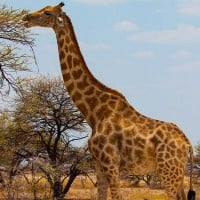 The giraffe is a tall African hoofed mammal belonging to the genus Giraffa. It is the tallest living terrestrial animal and the largest ruminant- hoofed herbivorous- on Earth. Traditionally, giraffes were thought to be one species, Giraffa camelopardalis, with nine subspecies. Most recently, researchers proposed dividing them into up to eight extant species due to new research into their mitochondrial and nuclear DNA, as well as morphological measurements. Seven other extinct species of Giraffa are known from the fossil record. ...read more.
The giraffe is a tall African hoofed mammal belonging to the genus Giraffa. It is the tallest living terrestrial animal and the largest ruminant- hoofed herbivorous- on Earth. Traditionally, giraffes were thought to be one species, Giraffa camelopardalis, with nine subspecies. Most recently, researchers proposed dividing them into up to eight extant species due to new research into their mitochondrial and nuclear DNA, as well as morphological measurements. Seven other extinct species of Giraffa are known from the fossil record. ...read more.
 The giraffe is a tall African hoofed mammal belonging to the genus Giraffa. It is the tallest living terrestrial animal and the largest ruminant- hoofed herbivorous- on Earth. Traditionally, giraffes were thought to be one species, Giraffa camelopardalis, with nine subspecies. Most recently, researchers proposed dividing them into up to eight extant species due to new research into their mitochondrial and nuclear DNA, as well as morphological measurements. Seven other extinct species of Giraffa are known from the fossil record. ...read more.
The giraffe is a tall African hoofed mammal belonging to the genus Giraffa. It is the tallest living terrestrial animal and the largest ruminant- hoofed herbivorous- on Earth. Traditionally, giraffes were thought to be one species, Giraffa camelopardalis, with nine subspecies. Most recently, researchers proposed dividing them into up to eight extant species due to new research into their mitochondrial and nuclear DNA, as well as morphological measurements. Seven other extinct species of Giraffa are known from the fossil record. ...read more.
13 Panda
 The giant panda (Ailuropoda melanoleuca), also known as the panda bear (or simply the panda), is a bear species endemic to China.
The giant panda (Ailuropoda melanoleuca), also known as the panda bear (or simply the panda), is a bear species endemic to China.
It is characterised by its bold black-and-white coat and rotund body. The name "giant panda" is sometimes used to distinguish it from the red panda, a neighboring musteloid. Though it belongs to the order Carnivora, the giant panda is a folivore, with bamboo shoots and leaves making up more than 99% of its diet. Giant pandas in the wild occasionally eat other grasses, wild tubers, or even meat in the form of birds, rodents, or carrion. In captivity, they may receive honey, eggs, fish, yams, shrub leaves, oranges, or bananas along with specially prepared food. ...read more.
 The giant panda (Ailuropoda melanoleuca), also known as the panda bear (or simply the panda), is a bear species endemic to China.
The giant panda (Ailuropoda melanoleuca), also known as the panda bear (or simply the panda), is a bear species endemic to China.It is characterised by its bold black-and-white coat and rotund body. The name "giant panda" is sometimes used to distinguish it from the red panda, a neighboring musteloid. Though it belongs to the order Carnivora, the giant panda is a folivore, with bamboo shoots and leaves making up more than 99% of its diet. Giant pandas in the wild occasionally eat other grasses, wild tubers, or even meat in the form of birds, rodents, or carrion. In captivity, they may receive honey, eggs, fish, yams, shrub leaves, oranges, or bananas along with specially prepared food. ...read more.
14 Sable
15 Serval
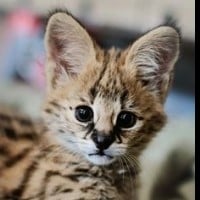 The serval is a medium-sized wild cat native to Africa. It is recognized for its distinctive coat, featuring a tawny background with bold black spots and stripes. Servals have a slender body, long legs, and large ears with excellent hearing capabilities. They are adapted to a semi-aquatic lifestyle, often found near wetlands or marshes. Servals are skilled hunters, preying on a variety of small animals like rodents, birds, and amphibians. They are known for their unique hunting technique of leaping into the air to catch birds in flight. Despite their striking appearance, servals are elusive creatures that are rarely seen in the wild.
The serval is a medium-sized wild cat native to Africa. It is recognized for its distinctive coat, featuring a tawny background with bold black spots and stripes. Servals have a slender body, long legs, and large ears with excellent hearing capabilities. They are adapted to a semi-aquatic lifestyle, often found near wetlands or marshes. Servals are skilled hunters, preying on a variety of small animals like rodents, birds, and amphibians. They are known for their unique hunting technique of leaping into the air to catch birds in flight. Despite their striking appearance, servals are elusive creatures that are rarely seen in the wild.
 The serval is a medium-sized wild cat native to Africa. It is recognized for its distinctive coat, featuring a tawny background with bold black spots and stripes. Servals have a slender body, long legs, and large ears with excellent hearing capabilities. They are adapted to a semi-aquatic lifestyle, often found near wetlands or marshes. Servals are skilled hunters, preying on a variety of small animals like rodents, birds, and amphibians. They are known for their unique hunting technique of leaping into the air to catch birds in flight. Despite their striking appearance, servals are elusive creatures that are rarely seen in the wild.
The serval is a medium-sized wild cat native to Africa. It is recognized for its distinctive coat, featuring a tawny background with bold black spots and stripes. Servals have a slender body, long legs, and large ears with excellent hearing capabilities. They are adapted to a semi-aquatic lifestyle, often found near wetlands or marshes. Servals are skilled hunters, preying on a variety of small animals like rodents, birds, and amphibians. They are known for their unique hunting technique of leaping into the air to catch birds in flight. Despite their striking appearance, servals are elusive creatures that are rarely seen in the wild.
16 Seal
 Pinnipeds, commonly known as seals, are a widely distributed and diverse clade of carnivorous, fin-footed, semiaquatic, mostly marine mammals in the clade Pinnipedia. They comprise the extant families Odobenidae (whose only living member is the walrus), Otariidae (the eared seals: sea lions and fur seals), and Phocidae (the earless seals, or true seals). There are 34 extant species of pinnipeds, and more than 50 extinct species have been described from fossils. While seals were historically thought to have descended from two ancestral lines, molecular evidence supports them as a monophyletic lineage (descended from one ancestral line). Pinnipeds belong to the order Carnivora; their closest living relatives are musteloids (weasels, raccoons, skunks, and red pandas), having diverged about 50 million years ago.
Pinnipeds, commonly known as seals, are a widely distributed and diverse clade of carnivorous, fin-footed, semiaquatic, mostly marine mammals in the clade Pinnipedia. They comprise the extant families Odobenidae (whose only living member is the walrus), Otariidae (the eared seals: sea lions and fur seals), and Phocidae (the earless seals, or true seals). There are 34 extant species of pinnipeds, and more than 50 extinct species have been described from fossils. While seals were historically thought to have descended from two ancestral lines, molecular evidence supports them as a monophyletic lineage (descended from one ancestral line). Pinnipeds belong to the order Carnivora; their closest living relatives are musteloids (weasels, raccoons, skunks, and red pandas), having diverged about 50 million years ago.
 Pinnipeds, commonly known as seals, are a widely distributed and diverse clade of carnivorous, fin-footed, semiaquatic, mostly marine mammals in the clade Pinnipedia. They comprise the extant families Odobenidae (whose only living member is the walrus), Otariidae (the eared seals: sea lions and fur seals), and Phocidae (the earless seals, or true seals). There are 34 extant species of pinnipeds, and more than 50 extinct species have been described from fossils. While seals were historically thought to have descended from two ancestral lines, molecular evidence supports them as a monophyletic lineage (descended from one ancestral line). Pinnipeds belong to the order Carnivora; their closest living relatives are musteloids (weasels, raccoons, skunks, and red pandas), having diverged about 50 million years ago.
Pinnipeds, commonly known as seals, are a widely distributed and diverse clade of carnivorous, fin-footed, semiaquatic, mostly marine mammals in the clade Pinnipedia. They comprise the extant families Odobenidae (whose only living member is the walrus), Otariidae (the eared seals: sea lions and fur seals), and Phocidae (the earless seals, or true seals). There are 34 extant species of pinnipeds, and more than 50 extinct species have been described from fossils. While seals were historically thought to have descended from two ancestral lines, molecular evidence supports them as a monophyletic lineage (descended from one ancestral line). Pinnipeds belong to the order Carnivora; their closest living relatives are musteloids (weasels, raccoons, skunks, and red pandas), having diverged about 50 million years ago.
17 Honey Badger
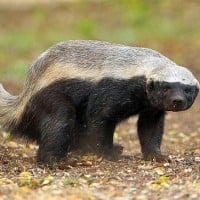 The honey badger, also known as the ratel, is widely distributed in Africa, Southwest Asia, and in the Indian subcontinent.
The honey badger, also known as the ratel, is widely distributed in Africa, Southwest Asia, and in the Indian subcontinent.
 The honey badger, also known as the ratel, is widely distributed in Africa, Southwest Asia, and in the Indian subcontinent.
The honey badger, also known as the ratel, is widely distributed in Africa, Southwest Asia, and in the Indian subcontinent.
18 Rat
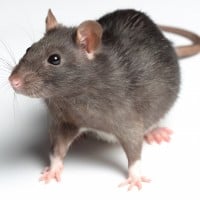 Rats are various medium-sized, long-tailed rodents of the superfamily Muroidea. "True rats" are members of the genus Rattus, the most important of which to humans are the black rat, Rattus rattus, and the brown rat, Rattus norvegicus.
Rats are various medium-sized, long-tailed rodents of the superfamily Muroidea. "True rats" are members of the genus Rattus, the most important of which to humans are the black rat, Rattus rattus, and the brown rat, Rattus norvegicus.
 Rats are various medium-sized, long-tailed rodents of the superfamily Muroidea. "True rats" are members of the genus Rattus, the most important of which to humans are the black rat, Rattus rattus, and the brown rat, Rattus norvegicus.
Rats are various medium-sized, long-tailed rodents of the superfamily Muroidea. "True rats" are members of the genus Rattus, the most important of which to humans are the black rat, Rattus rattus, and the brown rat, Rattus norvegicus.
19 Pangolin
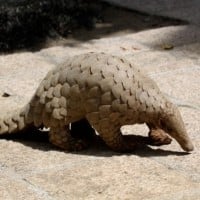

20 Dik-dik
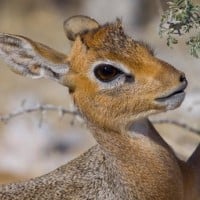 A small antelope species native to eastern and southern Africa, the Dik-Dik is known for its small size, generally standing less than 16 inches tall at the shoulder. They are herbivores that primarily consume leaves, fruits, and plants.
A small antelope species native to eastern and southern Africa, the Dik-Dik is known for its small size, generally standing less than 16 inches tall at the shoulder. They are herbivores that primarily consume leaves, fruits, and plants.
 A small antelope species native to eastern and southern Africa, the Dik-Dik is known for its small size, generally standing less than 16 inches tall at the shoulder. They are herbivores that primarily consume leaves, fruits, and plants.
A small antelope species native to eastern and southern Africa, the Dik-Dik is known for its small size, generally standing less than 16 inches tall at the shoulder. They are herbivores that primarily consume leaves, fruits, and plants.
21 Common Warthog
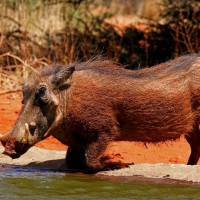

22 Malayan Tapir
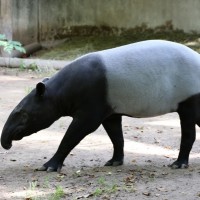

23 Aardvark
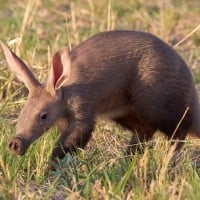

24 Gorilla
 Gorillas are herbivorous, predominantly ground-dwelling great apes that inhabit the tropical forests of equatorial Africa. The genus Gorilla is divided into two species: the eastern gorilla and the western gorilla, and either four or five subspecies. The DNA of gorillas is highly similar to that of humans, from 95 to 99% depending on what is included, and they are the next closest living relatives to humans after chimpanzees and bonobos.
Gorillas are herbivorous, predominantly ground-dwelling great apes that inhabit the tropical forests of equatorial Africa. The genus Gorilla is divided into two species: the eastern gorilla and the western gorilla, and either four or five subspecies. The DNA of gorillas is highly similar to that of humans, from 95 to 99% depending on what is included, and they are the next closest living relatives to humans after chimpanzees and bonobos.
Gorillas are the largest living primates, reaching heights between 1.25 and 1.8 metres, weights between 100 and 270 kg, and arm spans up to 2.6 metres, depending on species and sex. They tend to live in troops, with the leader being called a silverback. The Eastern gorilla is distinguished from the Western by darker fur colour and some other minor morphological differences. Gorillas tend to live 35–40 years in the wild. The oldest gorilla ever is Fatou (b. 1957), who is still alive at the advanced age of 65 years. ...read more.
 Gorillas are herbivorous, predominantly ground-dwelling great apes that inhabit the tropical forests of equatorial Africa. The genus Gorilla is divided into two species: the eastern gorilla and the western gorilla, and either four or five subspecies. The DNA of gorillas is highly similar to that of humans, from 95 to 99% depending on what is included, and they are the next closest living relatives to humans after chimpanzees and bonobos.
Gorillas are herbivorous, predominantly ground-dwelling great apes that inhabit the tropical forests of equatorial Africa. The genus Gorilla is divided into two species: the eastern gorilla and the western gorilla, and either four or five subspecies. The DNA of gorillas is highly similar to that of humans, from 95 to 99% depending on what is included, and they are the next closest living relatives to humans after chimpanzees and bonobos.Gorillas are the largest living primates, reaching heights between 1.25 and 1.8 metres, weights between 100 and 270 kg, and arm spans up to 2.6 metres, depending on species and sex. They tend to live in troops, with the leader being called a silverback. The Eastern gorilla is distinguished from the Western by darker fur colour and some other minor morphological differences. Gorillas tend to live 35–40 years in the wild. The oldest gorilla ever is Fatou (b. 1957), who is still alive at the advanced age of 65 years. ...read more.
25 Proboscis Monkey
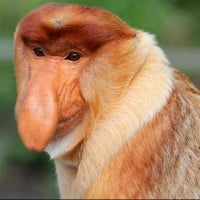 The proboscis monkey or long-nosed monkey, known as the bekantan in Indonesia, is a reddish-brown arboreal Old World monkey with an unusually large nose. It is endemic to the southeast Asian island of Borneo.
The proboscis monkey or long-nosed monkey, known as the bekantan in Indonesia, is a reddish-brown arboreal Old World monkey with an unusually large nose. It is endemic to the southeast Asian island of Borneo.
 The proboscis monkey or long-nosed monkey, known as the bekantan in Indonesia, is a reddish-brown arboreal Old World monkey with an unusually large nose. It is endemic to the southeast Asian island of Borneo.
The proboscis monkey or long-nosed monkey, known as the bekantan in Indonesia, is a reddish-brown arboreal Old World monkey with an unusually large nose. It is endemic to the southeast Asian island of Borneo.8Load More
PSearch List